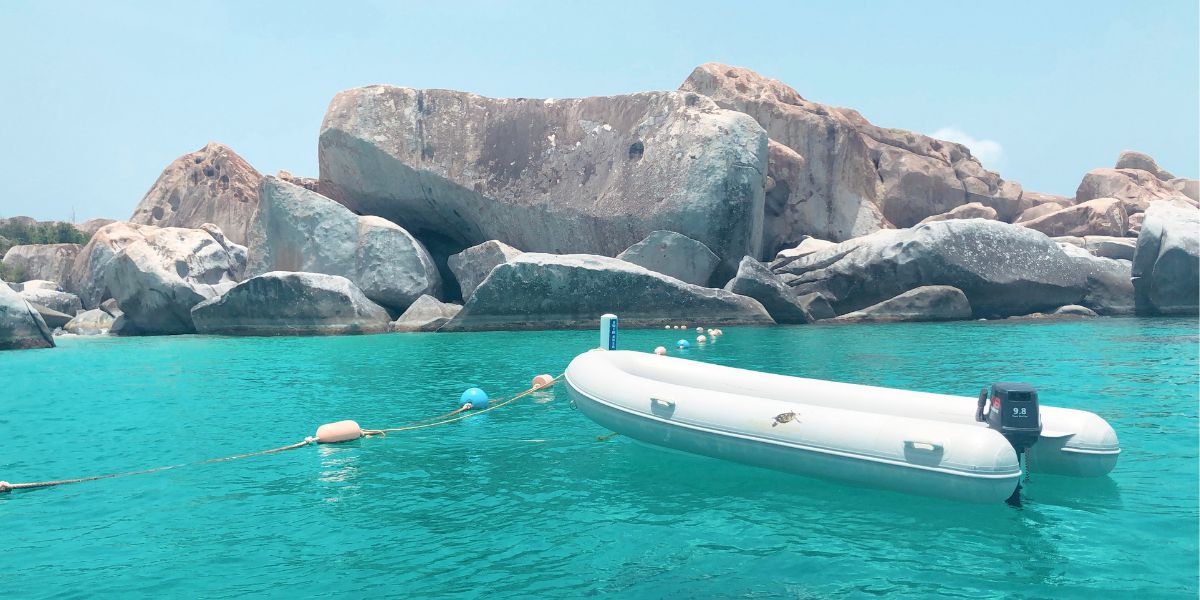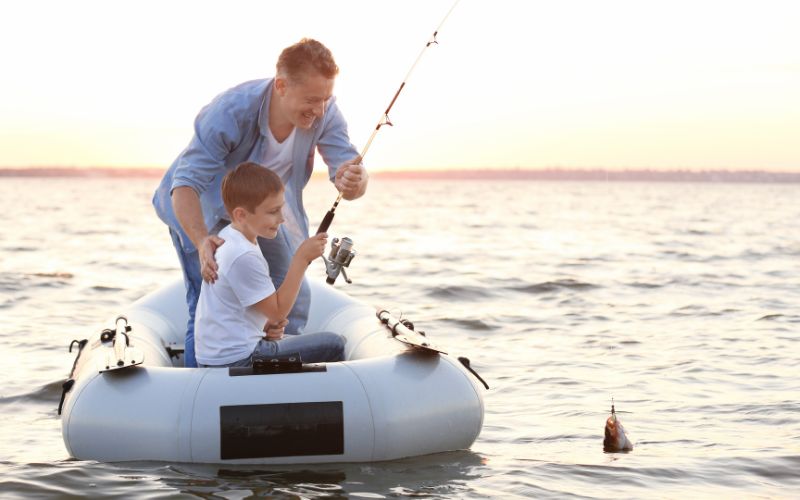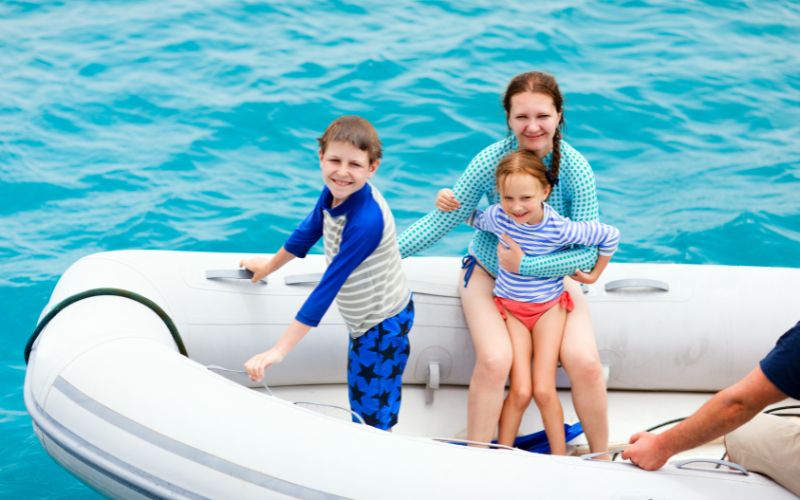As with any watercraft, there may be times when your inflatable boat will need an anchor. If you don’t want to be tossed around by the wind then you’ll need an anchor to help keep you in one place.

But at the same time, anchors are (by design) heavy and they can be cumbersome. So, how do you find a suitable anchor for a lightweight inflatable boat? Let’s take a look.
Do you need an anchor for a dinghy?
You don’t always need an anchor for a dinghy – it depends on what you’re using your boat for. If you are fishing or want to relax in a single spot, then an anchor will keep you in place. Anchors aren’t generally used at sea for inflatable boats.
Think about what you use an inflatable boat for. If you use one on a lake then it’ll either be for transport back and forth between one part of the lake and another, or it’ll be to fish, or just to unwind.
And generally, if you have an inflatable boat, you won’t store it on the water. Once you’ve finished with it, you’ll take it onto dry land and likely deflate it to keep it safe.
The job of an anchor is to keep you in one place, so if you’re using it as a mode of transport and you will be storing it on land, you don’t need to bother with an anchor.
But for days spent fishing or relaxing, an anchor is useful. It can keep you in place when the winds pick up, so you don’t lose your prime spot.
It’s a similar story at sea, where you might be doing some sea fishing but you’ll more likely be using an inflatable boat for a journey along the coastline. If you plan to fish in the sea then you may want an anchor, but there’s one extra thing to consider.
And that’s the waves of the ocean – they’re going to toss your inflatable boat around. If you have an anchor, it can be tricky to securely store it when your boat is bouncing off the waves in windy conditions.
So only take one with you if you need it.

How do you attach an anchor to an inflatable boat?
When it comes to how to attach an anchor to an inflatable boat, all that you need is the proper anchor and a bit of know-how.
1. Pick your anchor
This should be based on what you’ll be doing, and where (as in, ocean, lake, or river; sandy, rocky, etc.). The best anchors for inflatable boats are the squid anchor, the mushroom anchor, the fluke anchor, and the grapnel anchor, depending on the terrain.
2. Choose your rope
For inflatable boats, a rope is preferred to a chain as they’re lightweight and easier to store. A marine-quality rope is ideal, as these are specially made to resist damage from water, such as mildew.
Make sure that the rope is soft to the touch, so you’re not at risk of splinters or burns. It must also be long enough to reach the water’s floor (in the ocean, in particular, this may call for a lot of rope) or it simply won’t work.
3. Attach the anchor
The majority of inflatable boats will have rings in both the fore and the aft. This is the simplest place to attach your rope and anchor. Simply tying your anchor to the ring with a quality and durable rope will do the job.
How do you anchor an inflatable boat?
When anchoring an inflatable boat, choose your spot carefully to avoid other boating traffic. Ideally, you should anchor somewhere sheltered, if possible. Aim to drop anchor with your boat facing the current or wind direction, so that you don’t swing around violently. Lower the anchor – don’t drop it.
With the anchor attached, you just need to make sure you’re in a good position and then lower it to the floor of the water. Once it hits the bed, reverse your boat slightly just to help the anchor secure itself in place.
With that done, look around and identify a couple of landmark points. Use these to monitor your position – landmarks won’t move, so if they look like they have, it means you’re drifting.

What to Look For in an Anchor
- Durable marine-quality rope. This will be easier to coil and store than a chain. Marine quality is the best option, as it’s ultra-hardy and resistant to water-related damage, such as rot or mildew.
- The correct kind of anchor. This will depend on what water activity you’re doing, and where. For example, somewhere with sand and silt is perfect for a suctioning mushroom anchor. But for rocky terrain, you need something with a hook.
How heavy of an anchor do I need for an inflatable boat?
Most anchors designed for smaller boats weigh between 3.5lb and 20lb. The heavier the anchor you can comfortably store, the better – 12lbs is a good recommended minimum for most inflatable boats.
The bigger the boat, the heavier an anchor you need in order to keep it securely in position, but at the same time, you don’t want an anchor that’s too heavy for your craft.
Check the weight limits for your boat, bearing in mind any other equipment you’ll be carrying and your own body weight, and choose a suitable anchor that won’t put you at risk of sinking when you’ve got the anchor on board.
Why classic admiralty anchors should be avoided
A classic, heavy admiralty anchor for an inflatable boat will still work. It will just be a bit riskier and more inconvenient with an inflatable boat.
That’s because they are bulky and heavy. Storing them is harder on an inflatable boat, and they often weigh over 20lb, which is considerable – it can be tricky to heave them over the side of the boat.
And when your boat doesn’t weigh a lot, you could accidentally tip it over just while you’re trying to lower an anchor! Don’t worry though, as there are plenty of alternatives available.

Alternative lightweight types of anchor
Here are some options for anchors you may want to consider.
The Squid anchor
Perhaps the most popular choice for an inflatable boat is the squid anchor. This is an ingenious little creation that utilizes an empty bag, which can be filled with sand, rocks, tools, tackle, or debris once you need to anchor.
They also have two metal prongs that face outwards on the sides, with which to hook. You can empty squid anchor when you’re done, freeing you from the need to store a big, heavy anchor in your boat or pack.
Squid anchors work well in any terrain but you need to rely on having extra items to weigh them down.
The Mushroom anchor
The mushroom anchor is a fairly lightweight anchor. It is used primarily in water with a sandy or muddy floor. It gets its name from its round, bowl-like bottom and inner bar (resembling a wide-capped mushroom).
These anchors work best in mud or silt – where they can sink into the floor. They aren’t great where the terrain is rocky, as they don’t have the purchase to grab onto anything, and they can slide over the top of rocks.
This is considered a more ‘permanent’ sort of anchor, as it is often used for mooring, or to keep buoys in place better. It can also be used for fishing and other boating activities.
The Fluke Anchor
A fluke anchor closest resembles a traditional anchor. A fluke is a pointed end designed to dig into the terrain. Lightweight fluke anchors generally have a design that allows them to be folded for easy storage. The fluke anchor works best in sand or mud, but can also feasibly anchor onto a rock.
The Grapnel Anchor
Grapnel anchors look like a traditional grapnel, with multiple prongs that are designed to hook onto rocks and stones under the water. They’re not the best option for sand and silt, where the sharp points can just dig trenches without locking into place. But for more solid terrain they’re a good choice, and they can often fold away for easier storage.
What is the best anchor for inflatable boats?
There is no set kind of anchor that you use for a dinghy because it depends on the material on the bed of the water where you’ll use your inflatable boat. In rocky terrain, you’ll want a grapnel anchor, while a mushroom anchor is best if you’re always in sandy or muddy areas.
If you’re likely to use your boat in different places, a fluke anchor offers the best of both worlds, as does a squid anchor if you’re happy to fill it with debris every time you want to use it.
Where to stow your inflatable boat anchor
Inflatable boats generally don’t have a lot of storage space. Most people choose to store their anchor in the fore or aft, under the spray guard. This is nicely out of the way, yet quickly accessible in a fix.
Using rope rather than a chain, as it can coil up more tightly, will also make it easier to stow your boat anchor. By choosing a smaller anchor with a lightweight rope, you can minimize the space it needs and prevent it from taking up valuable room in your boat that would otherwise house your fishing gear.
Final word
Not everybody who owns an inflatable boat will need an anchor – they’re not an automatic purchase. But if you do plan on mooring your boat in the water, or securing yourself in one place while you relax or fish, then you’ll want to carry one with you.
Do your research into the place you’ll be using your boat primarily to get the most suitable style of anchor, but there are options available if you intend on using your boat in various terrains or at least having the option to do so.





